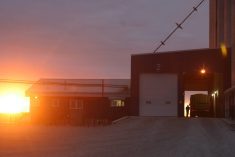A go-slow approach is the best way for school divisions to amalgamate, says the chair of a Saskatchewan school board.
Donnett Elder, of the Weyburn Central division, said she favours this province’s voluntary mergers, rather than the forced ones happening in neighbouring Manitoba.
In an interview at the Sask. School Trustees Association meeting Nov. 20, Elder said her board has had a motion on its books to merge with the Radville public school division.
“At our strategic planning this fall, the board agreed to look more closely at how this amalgamation could take place.”
Read Also

VIDEO: Bittersweet harvest for this family farmhand
Bruce Burnett helps his brother harvest wheat and canola for the last time on the family farm in Manitoba where they both grew up.
The Weyburn board has already taken some restructuring steps, said Elder. For 35 years it has shared a director with the Catholic system and recently it and four other boards totalling 2,000 students have reduced their administrative costs by sharing the services of a director, an assistant director and a superintendent of student services. They have also dovetailed their policies. As a result, said Elder, her division has been able to hire more specialists to deal with the extra demands now placed on schools, such as integrating mentally and physically handicapped students.
While amalgamation was one concern of the trustees, funding and a recent report examining the role of schools were also raised in a question session with several cabinet ministers. The report, which encourages delivering health and social service programs in the schools, has general approval from the trustees.
Who will pay
In talking about more money for schools, finance minister Eric Cline said it will be difficult to shift the current ratio in which local taxpayers pay 60 percent of their education bill and the Saskatchewan government pays 40 percent. Reversing the ratio would require another $200 million taken from other areas of the provincial budget.
“If it’s not raised through property tax, it’s got to come from somewhere,” the minister said.
Cline said provinces with lower education assessments on land and buildings raise the money for schools in other ways, such as higher payroll or sales taxes.
“Ontario took the property tax for education off but put on a property tax for health and social services.”
Another trustee asked if it was true the Saskatchewan government was planning on skimming four mills off the local property tax to put in a general education pool of money.
Education minister Jim Melenchuk said this was one of 10 possible ideas a committee is examining to smooth out the inequities of local tax funding. But no decisions have been made yet, he said. In the north, tax collections are meagre because few people own land. But a school division like Weyburn Central is self-sufficient even before getting its provincial operating grant because oil pays the way.
However even in “rich” Weyburn there was a tax revolt in 2000 with local ratepayers voting against paying the school assessment, said Elder.
She said farmers angry about their school tax bill should lobby the provincial government, not local trustees who are only applying their legislated authority.
















